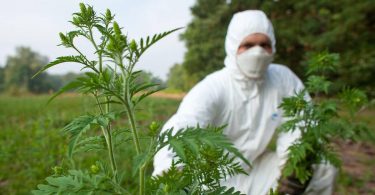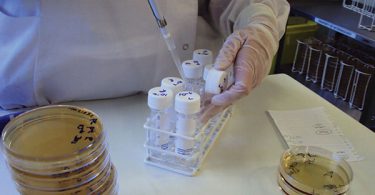ABSTRACT
Alopecia areata (AA) is an autoimmune disease characterised by localised, non-inflammatory, non-scarring hair loss . The disease usually affects hair on the head but may involve other parts of body. A case of a woman with alopecia areata treated successfully with Homoeopathy is reported here. She presented with single bald spot on scalp with hairfall and itching without any concomitant organ-specific autoimmune disorder. She was treated with homoeopathic medicines following holistic concepts of homoeopathy. Pulsatilla nigricans was given and the potency was selected and repeated as per the response of the medicine upon patient. The result was full recovery in period of treatment of approximately 5 months.
KEYWORDS
Alopecia areata, homoeopathy, Pulsatilla nigricans, simillimum
ABBREVIATIONS
Alopecia areata (AA), outpatient department (OPD), three times a day (TDS).
INTRODUCTION
Alopecia areata is a common autoimmune disorder which is presented as well-defined, localised, non-inflammatory, non-scarring patches of alopecia, usually on the scalp. Extensive involvement may
lead to total scalp hair loss (alopecia totalis), total body hair loss (alopecia universalis) or localised hair loss along the scalp margin (ophiasis). Pathognomonic ‘exclamation mark’ hairs are seen during active hair loss. These characteristic hairs break at their distal point as they taper and lose pigment proximally, giving them the appearance of an exclamation mark and occur at the periphery of patches of alopecia Nail abnormalities, predominantly pitting or roughening, may occur in association with this condition. Other organ-specific autoimmune disorders such as vitiligo, thyroid disease and down’s syndrome are occasionally associated with AA. [1,2]
The prognosis of the disease is unpredictable. Family history of AA, young age at onset, nail dystrophy, extensive hair loss, ophiasis, a history of atopy, or the presence of other autoimmune diseases are associated with a poor prognosis.[3] It is clearly evident through published case report that
homoeopathic treatment is useful in cases of AA.[4] This case report of AA is another effort in this regard.
CASE PROFILE:
A 45year female came in our OPD on 31st January 2019 with the complaint of hair fall along with root in the patch on scalp which lead to a single bald spot on scalp gradually increasing in size and falling of hair with itching on scalp, worse during sweating.
History of present complaints and treatment history:
Patient was apparently well 3 year back when she gradually developed hair fall along with roots in the patch on scalp. Initially, it was a small patch which gradually increased in size.
Physical generals: Thirst decreased. Perspiration profuse on scalp. Desire open air. Thermal reaction hot.
Mental generals: Anxiety when going in public places and crowded areas. Start weeping at trifles and on arguments. Feels better on consolation. Cannot remain alone, want someone to be with her.
General examination: Appearance – endomorphic, height – 5’1”; weight – 70 kilograms. Other general and systematic examination findings suggest no abnormal sign.
Local examination: On inspection of scalp, a single, smooth, sharply demarcated, round patches of hair loss without atrophy with “exclamation point hairs” observed on the periphery of the patches.
Totality of case:
1.Desire company can’t remain alone.
2.Anxiety in crowded areas
3.Weeping at trifles
4.Better on consolation.
5.Desire for open air
6.Perspiration profuse on scalp.
7. Falling of hair in patches.

8.Itching of scalp.
Figure 1: Repertorisation of case from Kent Repertory using RADAR OPUS Pro 1.41.16
software.
On reportorial analysis Pulsatilla nigricans have scored highest marks (16/7), while Lycopodium clavatum covering (14/7), Causticum covering (11/7) and Phosphorus covering (14/6).
First prescription with justification: Pulsatilla nigricans 200 one dose was prescribed after repertorisation on the basis of totality of symptoms and 200 potency prescribed according to susceptibility of patient and nature of medicine and disease. 200CH potency was selected and single dose was given to avoid any unwanted aggravation. Along with it Rubrum was given placebo for 15 days.
| Date | Symptoms | Prescription |
| 30.01.2019 | Falling of hairs in patches along with roots and with itching on scalp.(Figure 2) | Pulsatilla nigricans 200/1 dose Rubrum 30/TDS for 15 days |
| 16.02.2019 | Itching of scalp decreased, hairfall same | Rubrum1M/1dose Placebo 30/TDS for 20 days |
| 13.03.2019 | Hair fall and itching of scalp decreased. New hair growth seen in bald area. (Figure 3) | Rubrum1M/1dose Placebo 30/TDS for 10 days |
| 25.03.2019 | Dry cough, headache and fever(100*F) since yesterday with increased thirst. Circumference of bald spot is decreasing. | Placebo 30/TDS for 10 days |
| 10.04.2019 | Improvement in cough, headache and itching of scalp improved. Circumference of bald spot is decreasing. | Rubrum1M/1dose Placebo 30/TDS for 10 days |
| 24.04.2019 | Mild headache again, Hairfall is increasing. (Figure 4 ) | Pulsatilla nigricans 1M/1dose Rubrum 30/TDS for 20 days |
| 20.05.2019 | Hair fall decreased. Circumference of bald spot in decreasing with hair growth (Figure 5) | Rubrum1M/1dose Placebo 30/TDS for 10 days |
| 29.05.2019 | Marked decrease in bald spot | Rubrum1M/1dose Placebo 30/TDS for 20 days |
| 17.06.2019 | Improvement in all complaints | Rubrum1M/1dose Placebo 30/TDS for 20 days |
Table 1: Follow ups with prescription and justification
CONCLUSION AND JUSTIFICATION:
Physical appearance related issues have become almost important for individuals in this modern era. This was a case of Alopecia areata in a 45 year old female in which complete hair re-growth without any recurrence of bald patch and without any external application was achieved along with documentary evidence. This case shows positive role of homoeopathy in treating alopecia areata and confirms significance of prescription on the basis of reportorial approach and on the basis of totality of symptoms. Homoeopathy believes in holistic individualized approach. The outcome of this case
report will improve the knowledge of the clinicians, which will benefit patients suffering from alopecia areata. However, a prospective research study with randomised control trial (RCT) study design with larger sample size is suggested for scientific validation as this was a single case report.
Declaration of patient consent
The authors certify that they have obtained all
appropriate patient consent forms. In the form, the patient has given his
consent for his images and other clinical information to be reported in the
journal. The patient understands that his name and initial will not be
published, and due efforts will be made to conceal his identity, but anonymity
cannot be guaranteed.
Financial support and sponsorship
Nil.
Conflict of Interest
None.
References:
- Walker, B. R.,Colledge, N. R., Ralston, S.,Penman, I. D., & Britton, R.. Davidson’s principles and practice of medicine. 22nd ed. Edinburgh ; New York : Churchill Livingstone/Elsevier; 2014.
- Jones RM.ABC of dermatology. 6th ed.London : BMJ Books; 2014
- Darwin E, Hirt PA, Fertig R, Doliner B, Delcanto G, Jimenez JJ. Alopecia Areata: Review of Epidemiology, Clinical Features, Pathogenesis, and New Treatment Options. Int J Trichology. 2018;10(2):51–60. doi:10.4103/ijt.ijt_99_17
- Shivadikar AP. Evidence –bases homoeopathy: Case report of alopecia areata in an 11 year old boy. Indian J Res Homoeopathy [serial online] 2019 [cited 2020 Mar 15];13:215-5. Available from: http://www.ijrh.org/text.asp?2019/13/4/251/274017

Figure 2 -30/1/2019

Figure 3 – 13/3/2019

Figure 4 – 24/4/2019

Figure 5 – 20/5/2019





